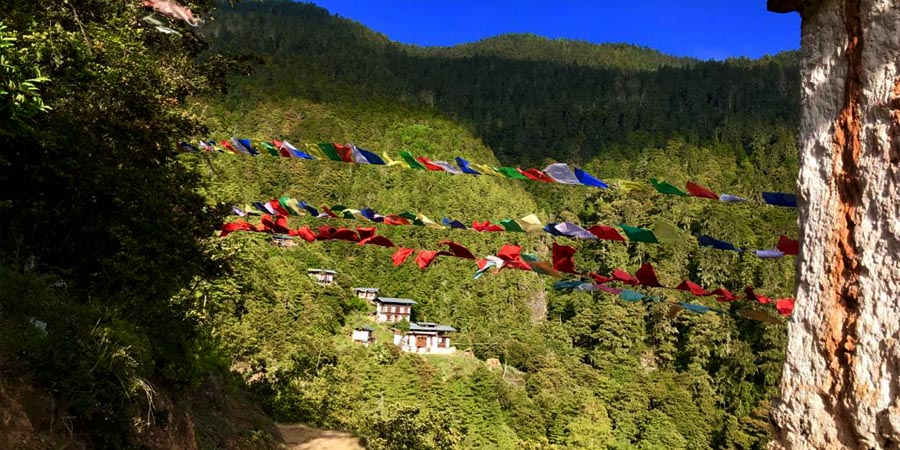Nestled in the heart of Paro, Bhutan, the Neyphug Monastery offers an extraordinary escape for those seeking both peace and spirituality. This sacred site, established in 1550 by the first Neyphug Trulku, is steeped in history and legends. The monastery’s celestial location on the sacred land of Chuden makes it an ideal destination for those looking to experience the tranquil atmosphere of Bhutan’s spiritual heartland.
Journey to Neyphug Monastery: A Scenic Drive Through the Bhutanese Wilderness
Reaching Neyphug Monastery is an experience in itself. The journey begins on a quiet dirt road that diverges from Shaba, Paro. The drive, which lasts about 45 minutes, offers a glimpse into Bhutan’s untouched natural beauty. The road meanders through secluded landscapes, providing a peaceful atmosphere as travelers venture toward the monastery. Along the way, visitors are likely to encounter Bhutan’s diverse wildlife, including playful monkeys, vibrant pheasants, and other rare birds that call this land home.
For many, the journey to Neyphug Monastery is as much a part of the experience as the destination itself. The tranquil surroundings set the stage for the spiritual discoveries to come. The monastery is home to several young monks, whose presence adds a sense of devotion and continuity to the holy site.
Neyphug Monastery’s Sacred Heritage and Spiritual Significance

Neyphug Monastery, also known as Heyphu Monastery, derives its name from the nearby Heyphu village. The monastery is also referred to as Thegchen Choling, or “Dharma Land of Vajrayana,” reflecting its significance in Vajrayana Buddhism. This sacred site holds special meaning for followers of the faith, as it is said to be home to several miraculous relics and teachings.
One of the most fascinating aspects of Neyphug Monastery is its connection to the 8th-century master Guru Rinpoche (Padmasambhava). Guru Rinpoche, a key figure in Bhutanese Buddhism, is said to have left his hand and foot imprints at the monastery, a symbol of his profound presence in the region. The monastery is believed to conceal many treasures, talismans, and sacred teachings that are still hidden to this day.
The Main Shrines and Sacred Relics of Neyphug Monastery
At the heart of Neyphug Monastery lies a series of awe-inspiring shrines, each one a testament to the deep spiritual legacy of the site. Among the most revered is the life-sized statue of Guru Padmasambhava, who is credited with spreading Buddhism in the region. Visitors can also see the revered shoes worn by Guru Padmasambhava, as well as his ritual hat, which holds special significance in Vajrayana rituals.
Another highlight of the monastery is a clay statue of Manjushri, the bodhisattva of wisdom, which is said to have miraculously flown from Tibet to its current location. This divine occurrence further enhances the mystical aura surrounding Neyphug Monastery.
For those seeking to deepen their spiritual connection with the monastery, there is an opportunity to make a wine offering to the temple’s protectors. These include Ekadzati, the five classes of Damchen, Dza Rahula, Tendoe, and statues of the five Gyalpo spirits, which were crafted by the Fifth Yangsi. These rituals are an important aspect of the spiritual experience at Neyphug, offering visitors a chance to participate in the monastery’s sacred traditions.
The Surrounding Sanctuaries: A Spiritual Journey Beyond Neyphug

The magic of Neyphug Monastery extends beyond its main shrines. The area surrounding the monastery is dotted with other sacred sites, each offering its own unique spiritual significance. A scenic one-hour walk from Neyphug will take visitors to a Stupa that houses the relics of Buddha Mahakasayapa, the Protector of Light. This sacred monument offers a serene space for meditation and reflection, further enhancing the monastery’s spiritual appeal.
For those who wish to continue their journey, a half-hour walk from the Stupa leads to Menchugang, where visitors can witness the miraculous self-arisen painting of Avalokitesvara, the bodhisattva of compassion. This painting is said to have appeared on its own, further fueling the mystique of the region.
A Magical and Mythical Landscape: Neyphug as a Sacred Land
Neyphug Monastery is not just a place of spiritual worship; it is also a land of myths and magic. The monastery is believed to be imbued with miraculous qualities, making it a truly otherworldly destination. The grounds of the monastery are home to wish-fulfilling trees, and travelers may even witness drops of nectar appearing from the rocks. Mantras are said to spontaneously appear on the rocks, adding to the sacred atmosphere of the site.
The monastery is also known for its several miraculous marks, which are thought to signify that Neyphug is the location of a hidden celestial land. This mystical energy is what draws visitors from all over the world, and it is not hard to understand why Neyphug is considered one of the most magical places in Bhutan. For those interested in the spiritual realm and the miraculous, Neyphug offers a rare glimpse into the sacred and mystical side of Bhutan.
Conclusion: A Magical Experience on Bhutan Luxury Tour
For those seeking a truly unique and enriching experience in Bhutan, a visit to Neyphug Monastery is an unmissable part of the journey. The combination of serene landscapes, spiritual heritage, and mystical experiences makes it one of the most magical destinations in the kingdom. Whether you are traveling for its rich history, breathtaking views, or spiritual enlightenment, Neyphug Monastery offers a profound and unforgettable experience.
As part of a Bhutan luxury tour, Neyphug Monastery provides the perfect opportunity to connect with Bhutan’s deep Buddhist traditions, enjoy the natural beauty of the region, and immerse yourself in the myths and magic that make this place so special. Whether you’re exploring its ancient relics or simply soaking in the serene atmosphere, Neyphug Monastery is sure to leave a lasting impression.

